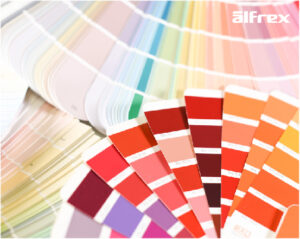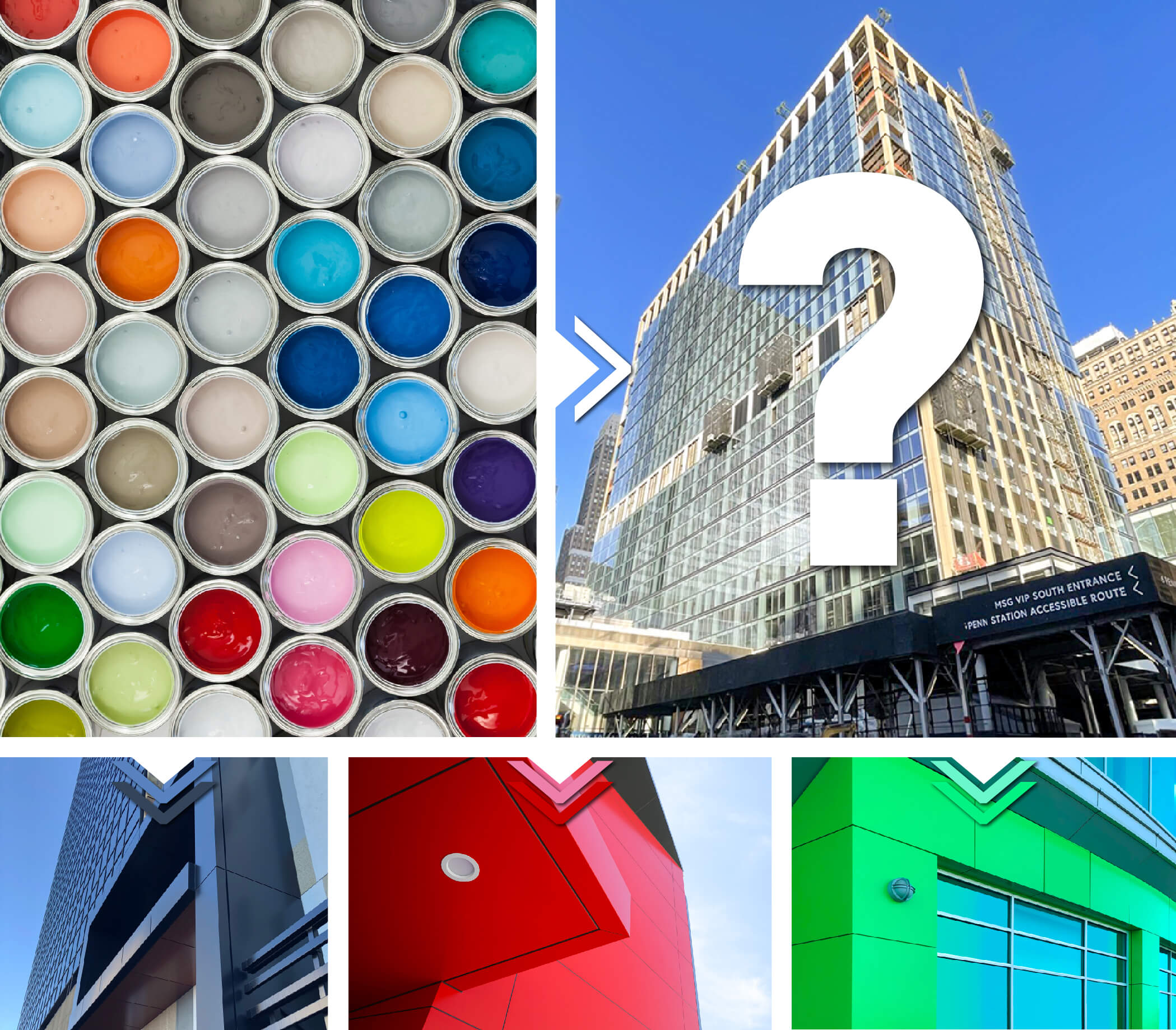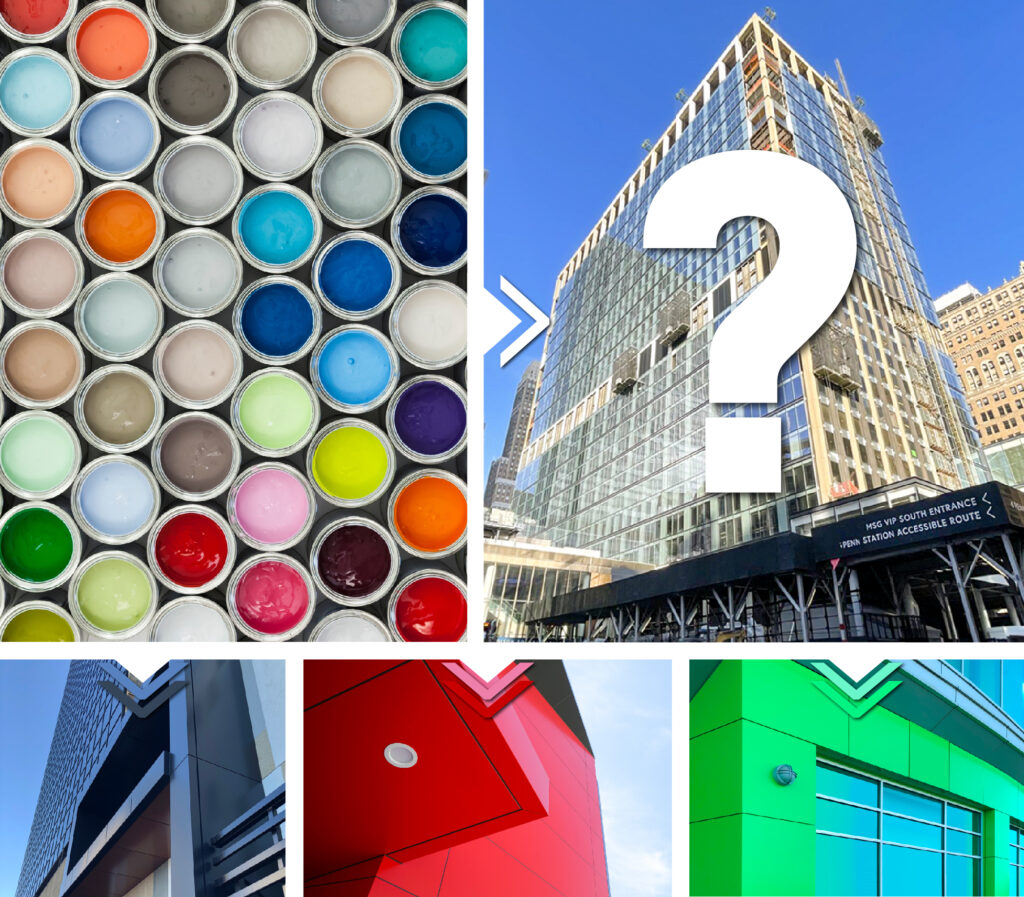Challenges Matching Popular Latex Paint Colors
As a manufacturer of Aluminum Composite Material (ACM / MCM) and pre-finished Aluminum Plate custom color matching is part of everyday business. Often times, exterior grade acrylic-latex paint finishes are chosen for an exterior architectural façade because of their appealing color range and numerous options within color families. As such, Alfrex has a library of paper color swatches from the most popular brands for just such an occasion. This library also extends to print color collections such as Pantone and RAL. When these colors are specified, the challenging process of matching those colors for application to Metal Composite Material, pre-finished aluminum plate, and aluminum flat sheet begins.
Color Matching

For these colors to be matched in an architectural finish coating system, Alfrex will send a paper color swatch from the color book to the proper architectural coating manufacturer for matching. If a coated metal sample can be supplied for matching, usually from a different product or substrate, that is even better.
The coating manufacturer (aka: paint company) will formulate a color match specifically for application to aluminum on a high-speed coil coating line that will meet the desired exterior finish performance warranty. This is in itself challenging since the primers, resins, and pigments used in architectural metal coatings are very different from those associated with acrylic-latex paints. When the specified color is akin to popular architectural wall cladding colors like whites, grays, and other similar earth tones, the process and results are straight forward with a high degree of success. On the other hand, when the desired color belongs to a more vibrant color family such as blues, reds, yellows, and oranges, achieving both the desired exterior UV performance and an acceptable color match is even more complex.
Color Hide
Color Hide is the ability of a color to decrease the amount of light passing through it which in turn, diminishes the effect of the primer coat on visual perception of the top-coat color. Many vibrant colors, particularly blues and reds, are more difficult in this aspect and often require 3-coat formulations in addition to the use of more exotic or expensive pigments. Even then, the process is still a delicate dance between color attributes and exterior performance.
The Game of Tradeoffs
Color matching for exterior architectural applications oftentimes becomes a game of tradeoffs. The first step in identifying an acceptable color match is identifying the coating system to be used. Each system type has advantages and disadvantages. For instance, while PVDF resin finishes will provide superior UV protection and exterior performance, gloss and color ranges are limited. FEVE resin coatings, on the other hand, provide excellent UV protection with superior gloss and color range, but are much more expensive and softer than PVDF. Finally, Super Durable Polyester coatings provide great gloss and color range but could very likely require a clear coat to achieve the exterior UV protection and warranty of a PVDF or FEVE resin finish. Even once a coating system is chosen, the paint manufacturer still has to work within the inherent limitations of various combinations of primers, resins, and pigments.
The Color Match Results

Achieving that “perfect match to the acrylic-latex color in the color book” for aluminum plate and aluminum composite panel (MCM wall cladding) is not as easy as one might think. A perfect color match may be possible, but there may be performance or warranty issues that make the “perfect color” not so “perfect”. So, keeping the desired exterior performance warranty in mind as a “must-have”, the aforementioned limitations may come into play as the coating manufacturer attempts to match the control sample. That deep blue, rich red, bright pastel, or other color may need to be “matched” more than once based on feedback from the architect on the initial effort. Even then, the final result may differ slightly. At the end of the day, it is a game of tradeoffs and the final result can be summed up with the statement “This is the best color match available that meets the highest number of criteria that have been defined.”



13 comments
Pingback:comprar androxal contra reenbolso
Pingback:purchase enclomiphene uk suppliers
Pingback:cheap rifaximin australia generic online
Pingback:ordering xifaxan ireland over the counter
Pingback:order staxyn uk delivery
Pingback:get avodart generic order
Pingback:cheap dutasteride medication interactions
Pingback:purchase flexeril cyclobenzaprine generic mastercard
Pingback:buy cheap gabapentin generic in usa
Pingback:canadian fildena with no prescription
Pingback:itraconazole cod overnight delivery
Pingback:kamagra žádná preskrpce
Pingback:kamagra consultation en ligne fedex cod gratuite